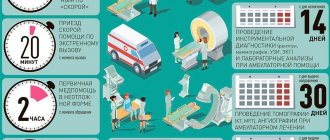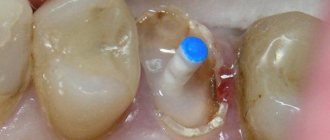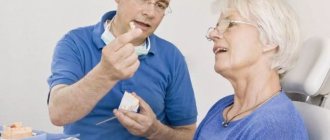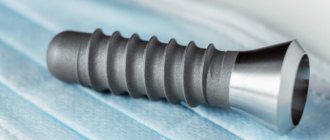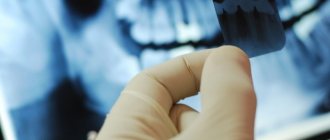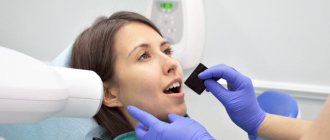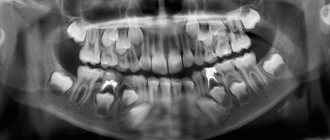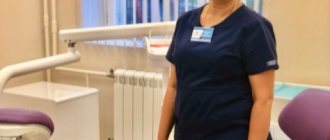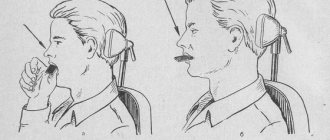Publication date: 03/26/2020
The Axioma Dental clinic has its own visiograph and orthopantomograph - this is digital X-ray equipment that allows you to achieve high efficiency in diagnosis and treatment. A visiograph is an ultra-sensitive technique for creating clear, accurate images of teeth. You no longer have to wait for the X-ray film to be developed; the image is instantly visualized on the screen. This saves the patient’s time without harming health.
An orthopantomograph is a safe alternative to X-ray machines. The technique takes a panoramic photograph of the patient’s entire dental system. The equipment is indispensable in any dental field for developing a treatment plan. The dentist can quickly make a diagnosis and obtain detailed information about the condition of the dental system.
The principle of operation of the visiograph
A dental visiograph is a system of equipment that includes an ultra-sensitive touch sensor, an X-ray, and a computer for digitizing data. The principle of operation of the technique is similar to x-rays, but it is a safe technique. If the film unit directs rays onto the film, then the visiograph imaging device sends data to an ultra-sensitive matrix, a CCD sensor. The microcircuit chip consists of photodiodes that can capture and visualize the smallest details.
The main advantage is that to create an image you need an ultra-low dose of X-ray radiation, only 2-3 μSv. This is safe for humans, and the doctor has the opportunity to reduce the time for diagnosis.
How to take pictures using a visiograph:
- The lead apron is protection for the patient, who wears it before the procedure.
- Placement of the sensor in the oral cavity - it can be wireless or wired. An individual protective cover is put on the sensor and placed in the oral cavity. The sensor is applied to the area where pathology is detected, the condition of the bone tissue is clarified for successful implantation, treatment of caries, pulpitis.
- The sensor of a dental touch imaging device is connected to a digital device for data visualization, digitization and analysis of results.
- Snapshot.
Within a few seconds, the doctor sees the full clinical picture on the PC screen, makes a diagnosis and quickly prescribes treatment.
Photo of teeth: types
Dental X-ray is a study of the soft and bone tissues of the oral cavity using an X-ray image. The image informs the doctor about what he does not see during a visual examination. X-rays are prescribed to identify the degree and depth of inflammation, detect pathologies, defects and diseases.
There are many types of dental x-rays. Our clinic uses targeted radiography. A targeted photograph of teeth is a simple and accessible technique in dental research. This is a 2D image that shows the doctor 1-2 teeth located nearby. Dental images are taken using a digital radiovisiograph.
Sight radiography allows the doctor to:
- Identify inflammation in the early stages in the area of the apexes of the roots of the teeth.
- Check the quality of tooth root filling and bone tissue restoration before prosthetics.
- Identify carious lesions, pulpitis, periodontitis.
A targeted photograph of teeth, depending on the equipment used, can be of two types:
- X-ray on film.
- Electronic image (the image is transferred to a digital medium, which allows you to enlarge the required area for detailed diagnostics).
The difference between a visiograph and an x-ray
A visiograph is a device that does not independently emit rays, unlike an X-ray machine. Its task is to receive the rays onto an ultra-sensitive sensor and convert them into an accurate image for data analysis. At the same time, modern equipment does not need to produce a wide beam of radiation. A radiovisiograph is a very thin targeted beam of light that is captured by a sensor.
The system’s sensor is able to recognize and capture the smallest particles of radiation in just a fraction of seconds, which reduces the procedure and risks for humans. Modern digital equipment differs from x-rays in the speed of obtaining an image; shutter speed:
- visiograph - 0.06 seconds.
- film apparatus - 0.6.
Conclusion - innovative technology allows you to achieve maximum safety for the patient and reduce procedure time.
How to take pictures with a visiograph. Brief instructions
Each device must have its own instructions, many of them are posted on our website. For example, for the Gendex GXS 700 digital visiograph you can see the instructions in the product description or look at this link, for the RX2 HP0 visiograph the instructions are available at this link and in the product description.
There are common points for working with different brands of visiographs that are used to take dental images. So, to obtain an X-ray of a tooth using a visiograph, the patient is put on a protective apron, which ensures that X-rays are blocked from the chest area. If this device is wired, then at the end of the cord there is a sensitive digital sensor with special software, on which a protective, disposable cover is put on. Next, this sensor is placed in the patient’s mouth and specifically placed on the tooth being diagnosed. Then the external unit of the X-ray unit is directed to the patient’s mouth and an image is taken, which is instantly transmitted to the computer monitor. This procedure is painless and safe. The radiation exposure to the patient is reduced by 10-16 times due to the high sensitivity of the sensor.
Next, the resulting image is viewed and, if necessary, processed for better visual perception using additional options installed in the software. X-ray images on a visiograph are easily transmitted electronically or viewed simultaneously on several remotely located computers. Thus, without developing the film or waiting, a highly effective and high-quality image is obtained, allowing you to obtain the most complete picture of the diseased tooth.
Advantages and disadvantages of a visiograph
Pros of sensory equipment:
- Minimum radiation dose.
- High image accuracy.
- Maximum safety for the patient.
- The procedure can be performed for pregnant women and children - consultation with a doctor is required.
- Compact device, able to work in a small office.
- Instantly visualize your photo without the need to develop film.
- The doctor gets the opportunity to see each tooth - multiple magnification of the image, storage of data on a PC, transmission via e-mail, local network.
- The manipulation takes several minutes.
- Editing a picture - the dentist uses different filters to improve the visual perception of the picture.
- The procedure is painless and does not require special preparation.
The disadvantage is the high price of equipment and procedures. But in modern dentistry, the priority is accurate diagnosis, effective treatment, and patient safety. Therefore, reputable clinics invest money in purchasing equipment.
Features of the orthopantomograph
Dental orthopantomograph is equipment for creating high-resolution panoramic images. Devices of various types have an overview imaging system, which makes it possible to visualize the entire jaw, the patient’s teeth, and jaw joints. The principle of operation is that the X-ray emitter and sensor in digital modifications rotate around the head, forming a clear three-dimensional image of the jaws.
Digital orthopantomographs make shooting as safe as possible for humans - the radiation level is 2-3 times less than with film units. Innovative technology does not require laboratories to develop images; the picture will be ready quickly and visualized on the computer screen without waiting for results.
If the orthopantomograph has a cephalostat, the doctor can take a frontal profile photograph of the skull, which is needed to build orthodontic structures.
Innovative technology works with different shooting programs:
- Standard overview.
- Separately upper and lower jaw.
- Photo of the maxillary sinuses.
- Children's photography.
- Image enlargement mode.
- Other programs for different clinical cases.
Safety, speed, high-resolution image quality, and information content are the characteristics of equipment used by clinics all over the world.
Visiograph in dentistry
Is it harmful to take x-rays during dental treatment? There are always many different misconceptions and myths around this topic, based on a phobia for everything that is somehow associated with radiation. Therefore, we will try to provide the necessary clarifications in this article so that you, dear patients, do not have unnecessary fears.
WHAT IS A VISIOGRAPHER AND HOW IS IT DIFFERENT FROM FILM X-RAY?
A visiograph is an electronic sensor that perceives x-ray radiation, transforms it into digital form and displays it on a computer screen. This is the most modern radiography system. In the old days, X-rays hit photographic film, which was then processed with solutions and an image was obtained.
In other words, a visiograph differs from an old film X-ray in the same way as a modern digital camera differs from an old film camera.
Since the visiograph sensor is an order of magnitude more sensitive than the best x-ray film, this leads to the first advantage of the visiograph - a very low radiation dose to the patient compared to film x-rays. About 10 times less! As a result, the radiation exposure received by the patient when using a visiograph is reduced to an insignificant minimum.
From this first advantage, the second automatically follows - now the doctor can afford to take as many pictures at a time as necessary for quality treatment, without fear for the patient’s health.
The third advantage of a visiograph is that the image appears on the computer screen instantly; there is no need to wait until the film is treated with special solutions and dries. This allows you to make decisions quickly.
The fourth advantage is the quality and size of the image. If previously the picture was on a tiny piece of film, on which it was difficult to see small details, now the picture can be enlarged directly on the computer screen as desired, printed in any size, and also instantly sent via the Internet anywhere in the world to other doctors for consultation.
Thus, the use of a visiograph for dental radiography raises the quality of treatment and diagnosis, as well as the safety of the patient and staff, to a higher level.
Most modern dental clinics use a visiograph, rather than the outdated film X-ray. Of course, there are still “dinosaurs” working the old fashioned way with film X-rays, but there are fewer and fewer of them.
From the very beginning, our clinic works only with a visiograph. We use a modern high-quality Planmeca system (Finland) for our work.
HOW MANY PICTURES CAN YOU TAKE AT ONE TIME?
This is the most concerning question for patients. Many people have a strong phobia of anything even remotely related to radiation. Therefore, we present the necessary numbers.
In medicine, X-ray procedures measure the dose received by the entire body - the effective equivalent dose, measured in Sieverts (Sv). But 1 Sievert is a fairly large unit, so microsieverts (µSv) are used. 1 Sv is equal to 1 million μSv.
According to our Russian standards (SanPiN 2.6.1.1192-03), which are very strict compared to the standards of other countries, during preventive medical X-ray procedures this dose should not exceed 1000 μSv per year. This is for prevention, but for therapeutic procedures this bar is much higher. 1000 μSv per year - is it a lot or a little?
The dose received from one image with a visiograph is 2 μSv. That is, to reach the annual norm of 1000 μSv, you need to take 500 pictures. Even if a patient visits the dentist 4 times a year and each time they take 5 pictures, that’s a total of 20 pictures per year. This is 25 times less than normal. But how many people visit the dentist 4 times a year?
If you take pictures not with a visiograph, but with an old film X-ray, then the dose will already be 15-20 μSv, i.e. 7-10 times more. But even this dose is not so much considering how often we visit the dentist.
Summarizing the above, it can be argued that there is no need to be afraid of receiving a significant dose during dental procedures. No matter how hard you try, it is unlikely that you will be able to go beyond the permissible values. Even if you take several pictures in a row at once, there is no need to panic and run to the store to buy a Geiger counter. To calm yourself, you can simply drink a glass of red wine - there will be no point, but your mood will immediately improve 
IS IT POSSIBLE TO DO X-RAYS FOR PREGNANT?
Medical standards say that pregnant women are prescribed for x-ray examinations only on clinical grounds, and examinations should, if possible, be carried out in the second half of pregnancy. At the same time, the standards establish a maximum dose of 1000 μSv for two months of undiagnosed pregnancy. And only if the fetus receives a dose 100 times higher than this maximum, the doctor is obliged to warn the patient about the possible consequences and recommend terminating the pregnancy.
As we already considered above, 1000 μSv is 500 images with a visiograph. Of course, in the first half of pregnancy, our clinic definitely does not recommend taking pictures, just in case, for your own peace of mind. And in the second half there are practically no restrictions.
And in general, reasonable people should understand that sources of ionizing radiation are not only found in medical offices. And you don’t have to live near Chernobyl to receive some doses from the environment. We are affected every second by both natural sources (sun, water, earth) and man-made ones. And the doses received from them are much greater than those received from an x-ray of a tooth. By avoiding radiation exposure at the dentist, people calmly sunbathe in the sun, watch TV, and talk for hours on a mobile phone. Pregnant women sit at home and watch TV series, surf the Internet and use mobile phones. Do they think about how many pictures they “took” while watching the next program, and then discussed it with friends on the forum and social networks? No, they don’t think about it, because the average person does not associate all this with ionizing radiation, unlike a picture in a doctor’s office. But in vain...
By the way, the background level of radiation that a person receives through air, water, food and other natural environmental factors is normally 4000 μSv per year, or 11 μSv per day. That's 5 pictures with a visiograph a day! Thus, the environment gives us a radiation dose tens or hundreds of times greater than a visiograph in a dental clinic, even if you are a regular patient and often have your teeth treated. And this is purely the environment, without taking into account man-made factors - computers, gadgets, mobile phones, wireless devices.
WHAT IS THE BEST PROTECTION TO USE? MAYBE IT'S BETTER TO WEAR 2 PROTECTIVE APRONS AT ONCE?
The number of aprons does not matter! The apron protects not from direct radiation, but from secondary, reflected radiation. To X-rays, the human body is like a glass cube to a flashlight beam: point the flashlight beam at one of the faces of a large glass cube, and, regardless of the thickness and direction of the beam, the entire cube will be illuminated. It’s the same with a person - you can swaddle him entirely in lead and shine only on his head - at least a little, but it will reach every point of the body.
That's all. We hope that your fears have diminished at least a little, and you will not worry yourself and the staff of dental clinics about every extra dental photograph.
Modern dentistry with visiograph and orthopantomograph
The technical equipment of the dental clinic is a guarantee of accurate diagnosis, effective treatment, and error-free diagnosis. Without the latest generation equipment, a medical institution cannot guarantee the patient a high level of service.
Axioma Dental Clinic is a center that invests money in purchasing innovative equipment. Doctors have a Sirona orthopantomograph and a visiograph at their disposal. This provides benefits to our patients:
- Examinations in one clinic - no need to waste time, sign up in advance for x-rays at clinics.
- Safety - there is no risk of receiving a high dose of X-rays.
- Treatment of children, adults, pregnant women - innovative equipment does not cause harm to health.
- Instant results - the photo will be ready in a few seconds.
The Axioma Dental clinic is the right approach to treating teeth, gums, correcting row defects, and implantation using safe equipment.
Sources:
- Yarnova E.A. Possibilities of radiation diagnostic methods in visualization of the temporomandibular joints in cases of dentofacial anomalies
- Goncharov I.Yu. Planning the surgical stage of dental implantation in the treatment of patients with various types of missing teeth, defects and deformations of the jaws, 2009
- Robustova Tatyana Grigorievna. Dental implantation: surgical aspects, 2003
Expert author:
Makanina Lina Viktorovna
Dentist-therapist
The information presented in this article is provided for reference purposes and does not replace the advice of a qualified specialist.
At the first signs of illness, you should consult a doctor.
Tell us about us:
